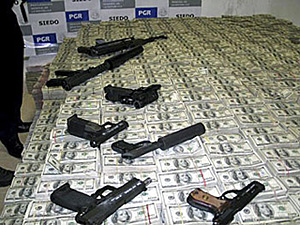
|
 |
 |
 Americas & Beyond | June 2008 Americas & Beyond | June 2008  
Fewer US Funds, Resources Allocated to Stem Drug Flow
 Brandi Grissom - El Paso Times Brandi Grissom - El Paso Times
go to original


| | More than marijuana, methamphetamine or other narcotics, lucrative cocaine is the drug around which the violence in Mexico revolves. | | |
Austin - The federal government has poured millions of dollars into stopping undocumented workers from crossing in remote border regions, but land ports lack the resources to prevent the flow of drugs and guns that fuel violence in Mexico, some experts and critics of U.S. border security policy said this week.

"It's designed to stop illegal immigration, undocumented workers, not so much for drugs," said Tony Payan, political science professor at the University of Texas at El Paso.

Payan and others said drug traffickers use ports of entry to transport much of their illicit wares, and the U.S. focus on areas between the ports has ignored some of the root causes of violence that some worry could spill north. But federal agents said criminals use all routes available to get their loads into the United States, and the agency that oversees land ports reported increased drug seizures this year and last.

"Any way that they can get dope across, they're going to try it," said Dan Stitt, assistant special agent in charge of the Drug Enforcement Administration in El Paso.

From 2006 to 2008, the budget for the U.S. Border Patrol, which is responsible for rural territory between the ports of entry, increased nearly 58 percent. During the same period, the agency that oversees the nation's sea, air and land ports, U.S. Customs and Border Protection, saw only an 11 percent bump in its budget.

Border Patrol has hired thousands more agents and installed new technology along the Rio Grande, and the federal government is spending billions to build barriers and fencing in the border hinterlands.

Payan said the discrepancy in funding shows that the government's focus has been on stopping undocumented workers from coming into the United States.

The lion's share of cocaine that comes to the country, he said, comes through border ports.

More than marijuana, methamphetamine or other narcotics, Payan said, lucrative cocaine is the drug around which the violence in Mexico revolves. Because the drug is so expensive, cartels don't want to risk crossing treacherous terrain.

Traffickers, he said, prefer instead to hide the drugs in merchandise or vehicles that can slip through border ports.

And he said the U.S. does little to control the movement of guns from the U.S. that wind up in the hands of Mexican cartels and gangs.

"The U.S. has to invest more in high tech for the traffic at ports of entry," Payan said.

A Government Accountability Office report from November states that Customs and Border Protection needs about $4 billion in infrastructure improvements and thousands of additional staff members.

In 2006, according the report, CBP agents prevented some 200,000 illegal crossings and seized about 600,000 pounds of drugs.

But the GAO investigation showed that many times inspections at land ports were not thorough and some officers did not stop vehicles for inspection or scrutinize pedestrians closely enough.

The GAO also found that vehicle barriers were lacking at several land crossings.

CBP officers, the GAO report found, were poorly trained, overworked and suffered low morale.

Monica Weisberg Stewart, chairwoman of the immigration committee of the Texas Border Coalition, said current border security policies ignore real problems on the border.

The border coalition, a group of border officials and business leaders, has sued the federal government over its plans for a border fence, claiming it is meant to stop workers the U.S. needs but doesn't address violent crime that plagues the border.

"If we are really looking for protection," said Weisberg Stewart, a merchant in downtown McAllen, "we don't have protection right now at our ports of entry."

Roger Maier, a CBP spokesman in El Paso, said officers at ports in West Texas and New Mexico have seized more drugs and made more arrests in the past two years.

"CBP officers working at El Paso ports of entry remain focused on the anti-terror mission, as well as some of our other enforcement concerns," Maier said in an e-mail.

While CBP officers apprehended more criminals and seized more drugs, U.S. Border Patrol in the El Paso sector reported drops in arrests and narcotics confiscations.

T.J. Bonner, president of the National Border Patrol Council, said increased security efforts in rural areas might be putting more pressure on the land ports, but the investments are only beginning to make up for years of neglect.

The investments might be one factor in reduced illegal immigration into the U.S., but he said drug flow into the U.S. hasn't abated.

Street prices for drugs, he said, have remained relatively flat, indicating the demand is not outpacing the supply.

"As long as there is a demand, there will be people looking to fill that demand by smuggling drugs across the border," Bonner said.

Jack Riley, special agent in charge of the DEA in El Paso, said traffickers will use every means possible to cross into the U.S.

The key to disrupting the drug flow and preventing the violence in Juárez from boiling over into El Paso, Riley said, is increasing communication among law enforcement on both sides of the border.

"They're trying to figure out ways they can exploit whatever weaknesses we have," Riley said.

Beefing up the border ports, U.S. Rep. Silvestre Reyes, D-Texas, said is the last step in securing the border. He has proposed spending $5 billion in the next five years to hire more agents, remodel facilities and upgrade technology.

"It's definitely part and parcel to the issue of border security," he said.

Brandi Grissom may be reached at bgrissom(at)elpasotimes.com | 
 | |
 |



